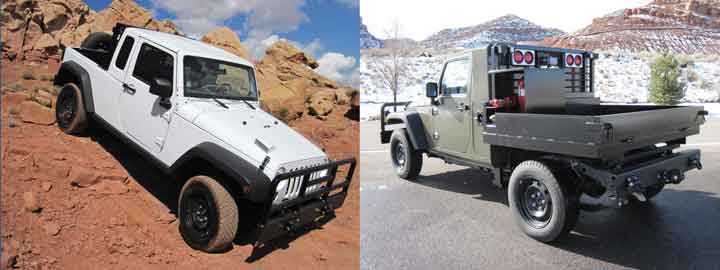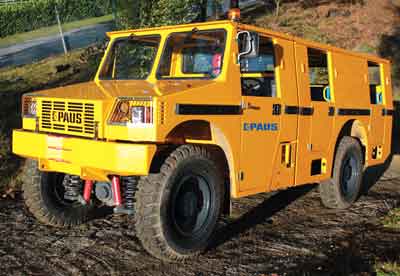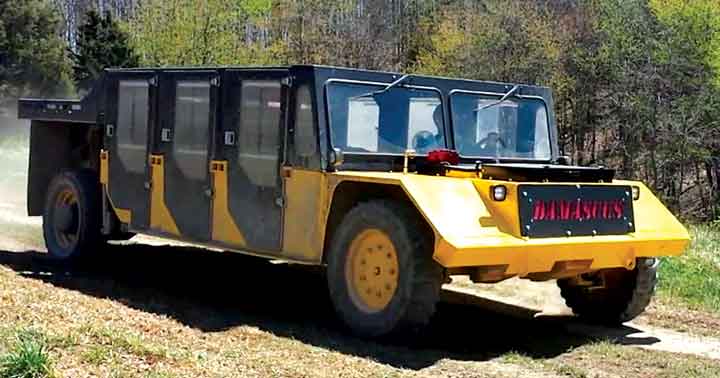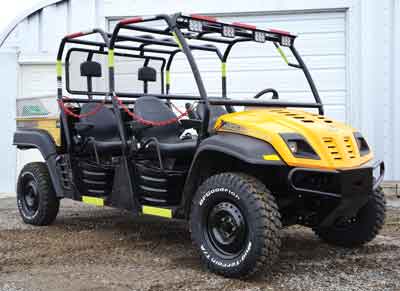
For years the mining industry had to make do with staff transport vehicles that were, frankly, not up to the job. Today, there is a much wider choice of robust, custom-build carriers.
By Simon Walker, European Editor
When it comes to personnel carriers, today’s mine manager now has a much wider range of options from which to choose. Some suppliers have gone down the route of producing combi-type utility vehicles that can be equipped with different load carriers, depending on the job at hand. Versatility is the selling point here, with the same power unit available to handle, for example, materials transport or a scissor-lift platform or personnel as required.
Another approach has been to take existing standard designs and make them stronger, as well as adapting engines to suit underground emissions requirements. A major benefit here is that most spares will be readily available from local dealers since the basic chassis is an “off-the-shelf” product.
And finally, there are those manufacturers who have analyzed the challenge in depth, and have come up with a new generation of people-carriers that are designed specifically to handle the physical mine environment. Heavily built, and often with a fairly minimalist approach to design, they offer the ultimate in durability when driving conditions are tough and roadway surfaces are rough. There is, of course, a quid pro quo here: built-in durability carries a substantial cost premium over the lighter-weight alternative.
CUSTOMIZED RAMS AND JEEPS
Utah-based Classic Motors Inc. (CMI) has more than 20 years of experience in modifying standard U.S.-produced vehicles for use underground, citing conversions of the heavy-duty Ram and Jeep J8 pickups as its core products.
Last year, Chrysler Group an-nounced the production of a version of its Jeep J8, specifically for underground mining, for sale exclusively in the North American market. Equipped with an Italian-built, 147-kW (197 hp) 2.8-liter turbo diesel engine, the underground J8 has a five-speed automatic transmission and four-wheel drive. The engine is approved by both the Mine Safety and Health Administration (MSHA) and CANMET for use in both hard rock and coal mining underground.
CMI reported that it can provide mining-grade vehicles based on the J8 in both two- and four-door formats, offering payloads of up to 1.2 metric tons (mt) or 2,566 lb. Its Ram and J8 conversions can provide carrying capacity for up to 10 people and, in the case of an emergency, can also provide stretcher transport.
The company noted that converting standard vehicles to meet MSHA and CANMET underground specifications involves a raft of modifications to both the fuel and electrical systems, as well as the installation of a fire suppression system. Included in the package is upgrading and protecting the truck’s fuel lines, installing protection beneath the fuel tank and installing a manual fuel shut-off valve. The engine control system is also adjusted to derate the engine to meet regulatory standards.
For the electrical system, cable harnesses that are potentially vulnerable to damage need to be rerouted through conduits, while all connections have to be sealed to reduce the potential for corrosion. A master switch is fitted to enable the power to be turned off if needed, with a special circuit that will shut down the engine should the fire-suppression system be activated.
THE UNBREAKABLE FROM BTI
From Canada, Breaker Technology Inc. (BTI) offers underground mines with two options for personnel transport: its MPV (multipurpose vehicle) Cassette Series, and the Mine Runner all-purpose vehicle. As the name suggests, the MPV features a common, center-articulated chassis on which a range of task-orientated cassettes can be mounted, including one for personnel. This has steel enclosed sides and provides two rows of padded bench seating, with customized deck sizes available.
BTI describes the Mine Runner as “a modern-day solution for a future-focused mining operation,” being neither a customized road vehicle nor a generic people carrier. Powered by an MSHA/CANMET-compliant 3.6-liter Deutz engine, it has hydraulic-wheel drive motors, providing greater power, and extended maintenance and duty cycles, the company said.
The braking system also operates through the drive motors and pump, so there are no brake pads to wear out or replace, while the use of a hydraulic drive means that there are no vulnerable mechanical drive components beneath the vehicle. Measuring 6.2 m (243 in.) long and 2.2 m wide in personnel carrier configuration, the Mine Runner has 318 mm (12.5 in.) of ground clearance and 180 mm (7 in.) of suspension travel, allowing it to negotiate seriously rough roadways.
The three-seat driver’s cab comes equipped to ROPS/FOPS standards, which can also be applied to the rear personnel unit if required. Looking nothing if not solidly built, the Mine Runner weighs in at 4.5 mt (10,000 lb) unladen, and can handle a 1.8-mt load at speeds of up to 40 km/h (25 mph).

MINE CRUISER FROM DOWN UNDER
Designed for transporting crews to and from the face in Australia’s coal industry, GE Mining Industrea’s Mine Cruiser is powered by a 4.3-liter, four-cylinder diesel engine that features a number of safety modifications that permit the vehicle to operate underground. With industry regulations that require external surfaces to stay below 150°C (302°F), the engine incorporates spark arresters while the exhaust manifold is encased in a water jacket to provide surface cooling. In addition, the exhaust gas is routed through a water bath for further cooling and particulates scrubbing — with the gas exiting at no hotter than 77°C (about 170°F), the company states.
As an option, the engine can also be fitted with an advanced shutdown system that is activated if a higher than permissible concentrations of methane are detected.
With more than 500 units sold to date, the Mine Cruiser is 6.4 m (21 ft) long and 2.1 m (7 ft) wide, weighing in at 5.4 mt unladen. Ground clearance to the chassis is 330 mm (13 in.). It has a 1.2-mt load capacity, and can provide seating for up to 11 people front and rear facing, or 12 with side-facing seats. The passenger compartment roof is designed to ROPS/FOPS standards, with additional protection available as an option.
MOBILITY FOR TOUGH CONDITIONS
According to the German manufacturer Paus, its MinCa utility vehicle has been designed specifically to work in extremely difficult mining conditions and in tunnels as narrow as 3.7 × 3.7 m (12 × 12 ft). Equipped with all-wheel drive and a suspension system that ensures that all four wheels remain in contact with the ground, the MinCa provides good maneuverability and driver comfort, as well as being very versatile, Paus added.
Capable of carrying a payload of up to 3.8 mt, the MinCa is available in a number of different versions with different fixed cassettes, including a personnel transporter with a capacity of up to 18 people. Power comes from a 90-kW Deutz water-cooled engine. The company noted that the high-torque hydrostatic drive and unique suspension principle with high ground clearance are all major benefits, guaranteeing maximum speeds even on extremely poor road surfaces or inclines. The MinCa is also available with all-wheel steering to enable it to operate in extremely confined haulages, and the driver’s cab is designed to hinge forward to provide better access for engine maintenance.
Paus’ second option for moving people underground is the 12-man personnel carrier version of its Universa 40, which is available in either a fixed configuration structure or as a “quick-change” model. Center articulation gives it the vehicle even better maneuverability than the MinCa, being able to operate in haulages as little as 3.25 m wide.
Paus said all of its vehicles have a spacious driver’s position, from where the driver has an excellent view of the vehicle and all its controls. Cabs are ROPS/FOPS-tested and feature a display for analyzing key vehicle data or error messages. All its machines also feature an SAHR braking system.

A MUTT WITH A PEDIGREE
With its production facilities in Abingdon, Virginia, Damascus Corp. has been producing people carriers for the mining industry since the 1980s. Its initial product range of three-wheel, battery-powered vehicles was soon supplemented by larger carriers with greater capacity, with the company then moving into diesel-powered vehicles as well. In 2013, it launched its most recent innovation, the diesel MUTT, which is designed to carry up to 12 people in coal roadways that are at least 1.8-m (6-ft) high.
The Mining Underground Transport Truck (or MUTT for short) has 460 mm (18 in.) of ground clearance and an overall height of 1.77 m (69.5 in.). Power is provided by an MSHA-approved, rear-mounted 115-kW (155-hp) Cummins QSB 4.5 engine, and a hydrostatic drive. This provides easy access for maintenance and provides weight over the rear wheels to improve traction, Damascus pointed out.
A big benefit is that the MUTT has automotive-style controls that make it easy for new operators to learn how to drive it. Rear cameras eliminate the need for mirrors, and the vehicle has hydrostatic braking, enclosed front and rear wet disc brakes and LED lighting. An enclosed cab with climate control is standard, with options including ROPS and FOPS protection and four-wheel drive.
Standard travel speed is 18.5 km/h (11.5 mph), although a top speed of 40 km/h (25 mph) is achievable. A manually actuated Ansul fire suppression system with engine shutoff is standard on the MUTT, with an automatic system also available.

SMALL AND SPEEDY
According to Canadian company United Personnel Carriers (UPC), there has always been a need for small utility/personnel carriers underground; the company was founded in 2008 on the basis of building a lower operating-cost-per-hour vehicle than any other similar utility/personnel carrier on the market.
UPC takes CubCadet Volunteer recreational utility vehicles and converts them into units suitable for mine supervisors and tradesmen to use. Both two- and four-seat versions are available, as well as a vehicle that can travel on both tires and rails.
The conversion to the Shifter 4×4D involves upgrading the braking system to SAHR, installing a long-life CVT system, heavy-duty LED lights, fireproof wiring and sealed controls, amongst other modifications. The machine is powered by a Tier 4-compliant, 16 kW (22 hp) Yanmar diesel engine with permanent four-wheel drive. Its carrying capacity is 360 kg (800 lb), with the passenger compartment protected by a rollover cage and by mesh panels around the rear seats.
Despite its operating weight of just 750 kg (about 1,652 lb) for the two-seat version, or 890 kg (about 1,962 lb) for a four-seater, the vehicle still offers 280 mm (11 in.) of ground clearance for use on rough underground haul roads. And the top speed? 20 km/h (about 12 mph).
This article was originally published in Engineering & Mining Journal. That version covered more units geared toward hard-rock mining.




